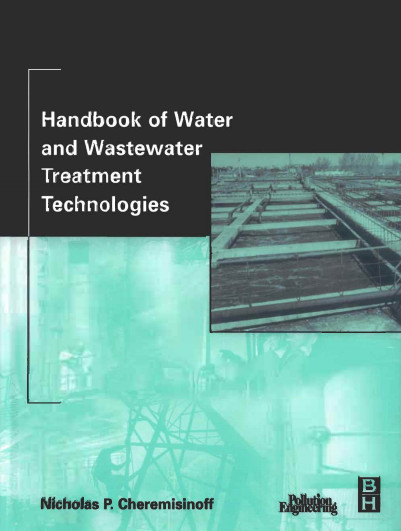Handbook of Water and Wastewater Treatment Technologies
 |
manuel Jan 2002 ; 654 pages ; prix indicatif: 105€
Aut. Nicholas P Cheremisinoff
Ed. Butterworth-Heinemann - Woburn ScienceDirect - Amsterdam ; Isbn: 978-0750674980
Téléchargeable chez l'éditeur
Page de présentation d'un éditeur
Abstract:
This volume covers the technologies that are applied to the treatment and purification of water.
This Handbook is an authoritative reference for process and plant engineers, water treatment plant operators and environmental consultants. Practical information is provided for application to the treatment of drinking water and to industrial and municipal wastewater. The author presents material for those concerned with meeting government regulations, reducing or avoiding fines for violations, and making cost-effective decisions while producing a high quality of water via physical, chemical, and thermal techniques.
There are twelve chapters.
The first of these provides an orientation of terms and concepts, along with reasons why water treatment practices are needed. This chapter also sets the stage for the balance of the book by providing an organizational structure to the subjects discussed.
The second chapter covers the AB-Cs of filtration theory and practices, which is one of the fundamental unit operations addressed in several chapters of the book.
Chapter 3 begins to discuss the chemistry of wastewater and focuses in on the use of chemical additives that assist in physical separation processes for suspended solids.
Chapters 4 through 7 cover technology-specific filtration practices. There is a wide range of hardware options covered in these three chapters, with applications to both municipal and industrial sides of the equation.
Chapter 8 covers the subjects of sedimentation, clarification flotation, and coalescence, and gets us back into some of the chemistry issues that are important achieving high quality water.
Chapter 9 covers membrane separation technologies which are applied to the purification of drinking water.
Chapter 10 covers two very important water purification technologies that have found applications not only in drinking water supply and beverage industry applications, but in groundwater remediation applications. These technologies are ion exchange and carbon adsorption.
Chapter 11 covers chemical and non-chemical water sterilization technologies, which are critical to providing high quality drinking water.
The last chapter focuses on the solid waste of wastewater treatment - sludge. This chapter looks not only at physico-chemical and thermal methods of sludge dewatering, but we explore what can be done with these wastes and their impact on the overall costs that are associated with a water treatment plant operation. Sludge, like water, can be conditioned and sterilized, thereby transforming it from a costly waste, requiring disposal, to a useful byproduct that can enter into secondary markets. Particular emphasis is given to pollution prevention technologies that are not only more environmentally friendly than conventional waste disposal practices, but more cost effective.
Public-Cible:
Mots clefs: |
boues (traitement des ) (CI) (DT) (OP) (ope) , eaux usées (traitement des ) (CI) (DT) (OP) (ope) , sciences de l'ingénieur (CI) (DT) (OP) (ope) , technologie (CI) (DT) (OP) (ope) |
Editeurs/Diffuseurs: |
|
Butterworth-Heinemann - Woburn - Etats Unis |
ScienceDirect
-
Elsevier - Amsterdam - Pays Bas |
En cas de lien brisé, nous le mentionner à communication@pseau.org